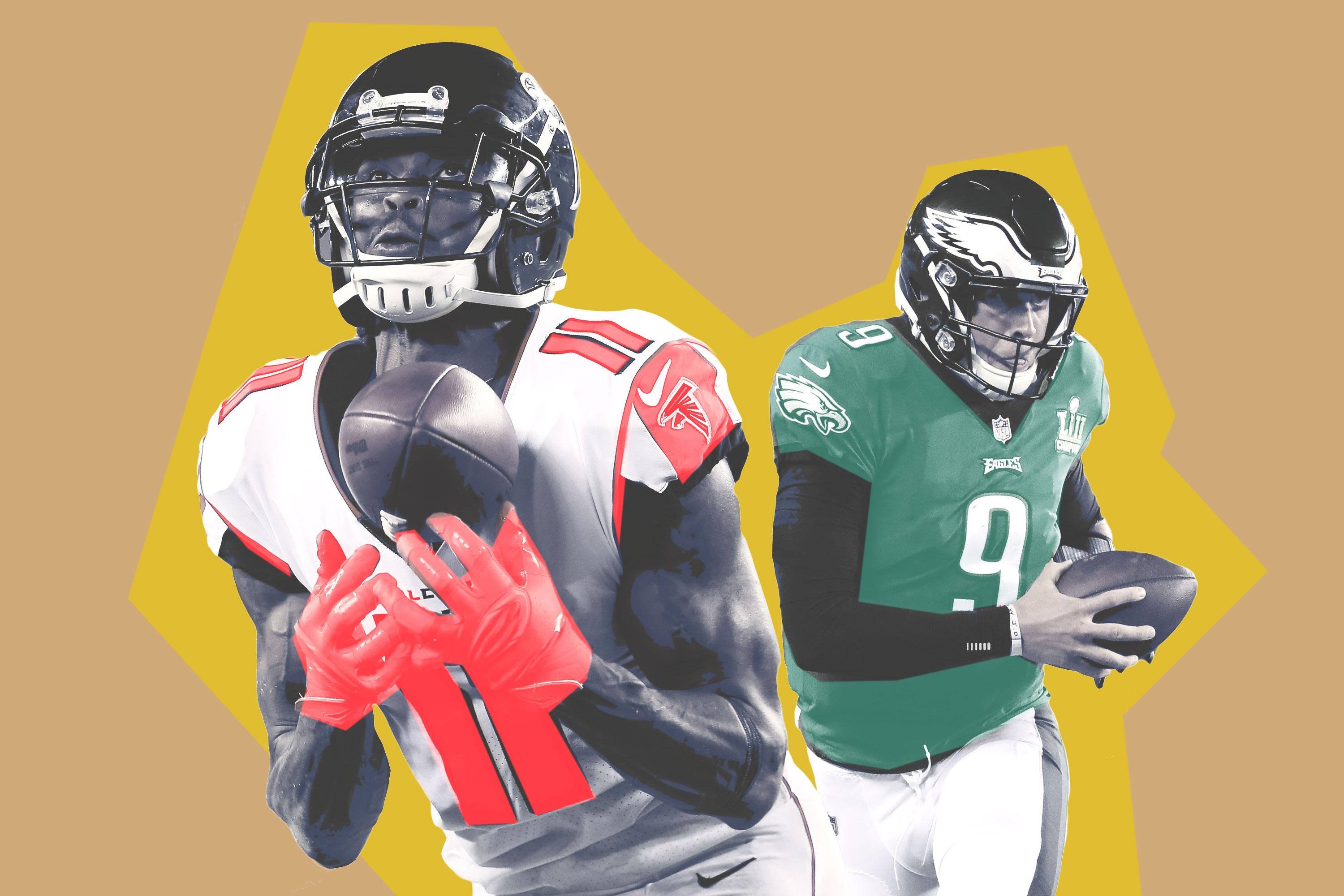
The lightning storm that rolled into Philadelphia on Thursday night, which sent fans scurrying for cover and delayed the start of the NFL season opener, turned out to be a harbinger for what was to come. For most of the game, the Falcons and Eagles took turns making unforced errors, giving up ill-timed turnovers, and struggling in the red zone. It was an ugly affair, one that wouldn’t have felt complete without the first catch-rule controversy of the season. But while the 2018 season got off to a mostly sloppy, penalty-ridden start, the Eagles’ narrow 18-12 win was not without its share of exciting, edge-of-your-seat moments, too—and a few of those plays shed light on big questions we’ve had about both teams during the run-up to the season.
Every game features dozens of plays and hundreds of individual battles, and each and every one of those unique matchups matters. But with NFL teams so closely matched, winning or losing often comes down to a handful of pivotal moments. The NFL opener was no exception: Here are five of the biggest game-changing plays from the first matchup of the year, along with what they can tell us about the Eagles, Falcons, and the upcoming season.
The Falcons Try, and Fail, on Fourth-and-Goal From the 1-Yard Line
Aided by a 20-yard Devonta Freeman run and a 33-yard reception by Julio Jones, Matt Ryan skillfully piloted the offense down to the Philly 1-yard line on Atlanta’s opening drive. Then everything fell apart: The team’s second-down run was stuffed, Ryan’s third-down pass fell incomplete, and head coach Dan Quinn decided to thumb his nose at convention and try to punch it in for six.
Maybe it was the fact that Quinn was matched up against Doug Pederson, the ballsiest fourth-down play-caller in the league by a long shot last year, or maybe it signals a new leaguewide attitude toward more aggressive decision-making on that crucial down (we’ll find out—it’s a copycat league, after all). But Quinn quickly signaled to his offense to stay out on the field and go for it. That chutzpah, I loved; the play that offensive coordinator Steve Sarkisian dialed up, I did not. The Falcons sent Jones to the bench and (with the exact same look that they used on that stuffed second-down rush attempt) lined up in a three-tight-end, two-running-back set, condensing all 11 of their offensive players into the middle of the field.

In response, the Eagles crowded the box with 11 defenders of their own. Running against stacked boxes is generally highly inefficient, especially when you’re talking nine, 10, or 11 defenders, as we see above. The defense has a mathematical advantage over offensive blockers in those looks (because Ryan’s not blocking anyone), and that’s why, in the modern NFL, you see more teams spreading out to run in short-yardage situations. Putting three or more receivers on the outside of the formation forces defenses to defend more of the field, opening up space in the middle with which to run.
Unsurprisingly, Philly overwhelmed Atlanta’s scheme to stuff the play.
This goal-line stand by the Eagles conjured memories of last year’s NFC divisional playoff matchup between these two teams, which the Falcons lost after failing to convert on fourth-and-goal from the 2-yard line with just over a minute to go. It also foreshadowed the ending of this game and magnified what is clearly the Falcons’ most glaring weakness: executing in the red zone (more on that in a bit).
The Philly Special 2.0 (Sorta)
At first glance, the trick play the Eagles ran to convert a third-and-5 from the Falcons’ 41-yard line with 7:41 left in the third quarter looked a lot like the famous Super Bowl “Philly Special.” In fact, even the Eagles’ official Twitter account implied it was the same play, and the moniker “Philly Special 2.0” quickly took hold.
But it’s a bit different from what the Eagles ran against the Patriots in February. Instead of the running back receiving a direct snap, Nick Foles got the ball in the shotgun before handing off to running back Corey Clement. Clement then flipped it to Nelson Agholor, who ran an end-around motion across the field before tossing it downfield to Foles for a big gain.
That wasn’t technically the Philly Special 2.0; actually, it was basically the same play the Patriots ran in the Super Bowl—only New England had less success with it.
It was an amazing troll job by Pederson and sparked the Eagles offense, which, to that point, had looked uninspired. Philly marched down the field and, five plays later, scored a go-ahead touchdown.
After the game, Pederson noted that this particular iteration of the play, at least in the Eagles’ playbook, is called the Philly Philly. The Eagles may be running out of chances to use that type of trick, but it illustrates a slowly changing attitude that favors aggressive, nontraditional play-calling in key situations. There’s an old maxim that fortune favors the bold, and the Eagles are clearly buying into that. The NFL at large may soon follow.
Matt Ryan Picked Off at the 1-Yard Line
Trailing 10-6 early in the fourth quarter on a third-and-3 from the Philadelphia 15-yard line, Ryan threw up a wobbly rainbow toward Jones, and while it’s not clear whether the pass was off target or Ryan and Jones simply weren’t on the same page routewise, it fell way short and was intercepted.
The Falcons defense bailed Ryan out on the next series by picking Foles off, which set up Atlanta’s go-ahead score—but that badly underthrown pass was representative of a bigger issue that seemed to rear its head in this game: a noticeable lack of zip on the veteran passer’s throws.
This pass from the second quarter seemed to take all day to get to Jones …
… and so did this one …
… and this one:
Ryan ended the game 21-of-43 (his first sub–50 percent passing game since 2011) for 251 yards and a pick, with a 57.4 passer rating. It may have just been an off day for throwing the ball, but for a guy who just signed a five-year, $150 million deal in the offseason, the lack of velocity and accuracy has to be a concern.
The Go-Ahead Touchdown Run
With 2:25 to go, Eagles running back Jay Ajayi took a handoff, got to the outside, and cut downfield, exploding past the Atlanta defense and breaking a tackle en route to the go-ahead score.
That touchdown, Ajayi’s second of the day, should allay some fears about the knee issue the team had been monitoring during the preseason. But it was definitely interesting how the Eagles rotated their running backs throughout the game.
Darren Sproles got the start, carrying the ball five times for 10 yards while adding four catches for 22 yards, and the longtime vet was used heavily early on. As the game wore on, Ajayi gradually got his reps, earning his first carry at the 13:37 mark of the second quarter before finishing with 15 totes for 62 yards at 4.1 yards per carry. And the team sprinkled Clement in as well (five carries for 26 yards).
The go-ahead, fourth-quarter scoring drive might be the perfect microcosm of how the Eagles split reps among their backs this season. On that drive, Pederson went with a rotation: Sproles caught two passes, including one key third-down conversion; Clement carried it twice, picking up 24 yards; and Ajayi finished the job, bowling in from 11 yards out. We’ll see whether that’s a sign of things to come.
Déjà Vu All Over Again
The rematch of last year’s NFC divisional round game played out much like the original bout—a game that Philadelphia won 15-10 after holding the Falcons out of the end zone on four straight pass attempts by Ryan, the last of which was dropped by Jones (who also landed out of bounds). And despite making it a focus over the offseason, for the second straight game, the Falcons’ late-game red zone offense crumbled.
Trailing 18-12 with 23 seconds to go, the Falcons had a first-and-goal from the 10-yard line. On first down, Ryan dropped back and, seeing nothing, rolled to his right and threw the ball out of bounds. On second down, Ryan targeted Jones up the seam, airmailing the pass about 5 feet over his receiver’s head. On third down, he was pressured, and threw an errant pass before being clobbered. On fourth down, he again lobbed a pass down the seam—this time to triple-covered tight end Austin Hooper, and that pass sailed out of bounds. That would’ve been the game ender, but Atlanta got an illegal contact penalty in its favor, and that gave the team one last shot. With one second left, Ryan threw a back-shoulder fade to Jones but led him too far outside. Jones caught it but, once again, landed out of bounds.
Ryan finished 1-of-9 passing in the red zone Thursday, per ESPN Stats and Info, and is now just 1-of-20 targeting Jones in the end zone over the past two seasons (including playoffs). Something has to change, Quinn admitted after the game, which is concerning, considering the time to implement changes was the last six months. The Falcons have too much talent on offense to be this bad in the red zone. They need more from Sarkisian, more from Ryan, and more from Jones in that area if they hope to compete in a very tough NFC this year.

